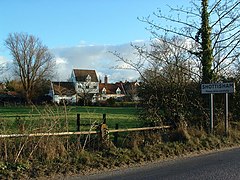Shottisham
| Shottisham | |
|---|---|
 Shottisham Watermill |
|
| Shottisham shown within Suffolk | |
| Population | 197 (2011) |
| OS grid reference | TM 31995 44647 |
| • London | 98.9 mi (159.2 km) |
| Civil parish |
|
| District | |
| Shire county | |
| Region | |
| Country | England |
| Sovereign state | United Kingdom |
| Post town | Woodbridge |
| Postcode district | IP12 3 |
| Police | Suffolk |
| Fire | Suffolk |
| Ambulance | East of England |
| EU Parliament | East of England |
Shottisham is a village and civil parish in the Suffolk Coastal District, in the county of Suffolk. It lies in the Wilford Hundred, about four and a half miles south-east of Woodbridge, between the parishes of Sutton, Alderton, Ramsholt and Hollesley, in the Bawdsey peninsula. About three miles from the coast at Hollesley Bay and Shingle Street, the village street overlooks a slight hollow of meads and copses at the road crossing of Shottisham Creek, a tributary brook of the river Deben.
The origins of Shottisham and its name can be traced back to Old English, being translated to 'Scot or *Sceot's homestead/village'. The earliest history of Shottisham is recorded in the 1086 Domesday Book and is described as being located in the Wilford Hundred. Shottisham had 24 households which was quite large compared to other nearby village parishes, containing 1 smallholder and 15 free men. The land was valued at £1.8, of which the overlords at this time were Edric of Laxfield and Godric of Peyton. St Margaret's, the medieval parish church, which has a square tower holding a single bell, was restored in 1845.
As of 1966 the church of St Margaret became a listed building by English Heritage. Parish boundary records for Shottisham date back to 1831. The village then had 2,320 acres of land: however this figure had reduced by 1881 to 1,884 acres owing to parish boundary changes.
Population census data from 1801 records 161 inhabitants, and by the 2011 census this had risen to 197. The 1851 census shows the highest figure, with 372 people.
Occupational statistics from Census data show that in 1831 just over 60% of residents were employed as agricultural labourers. Retail and Handicrafts accounted for a further 28% of the population. The data for 1881 shows still the majority of men (around 66%) as agricultural labourers. The largest employment sector for women (20%) was in Domestic services of offices.
...
Wikipedia

